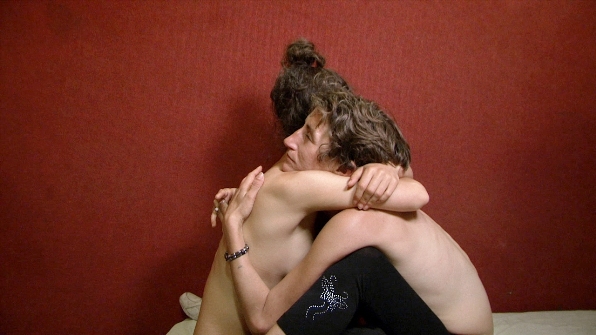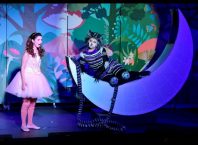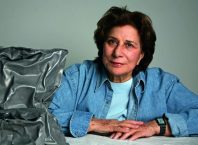
Prolonged Exposure, an exhibit curated by Maayan Sheleff, opened last night at the Center for Contemporary Art, Tel Aviv, and will remain open through June 23, 2011. The participating artists include: Yael Brandt, Breaking the Silence (with Miki Kratsman and Avi Mograbi), Lana Čmajčanin, Juan Manuel Echavarria, Julia Meltzer and David Thorne (with Rami Farah), Avi Mograbi, Christoph Weber, Rona Yefman and Mich’ael Zupraner. The Center for Contemporary Art is located on 5 Kalisher St. Tel Aviv, opening hours are: Monday – Thursday: 14:00 – 19:00; Friday, Saturday: 10:00 – 14:00. For additional information, call: 03-51061111.
Information on the exhibit from the press release:
In photography, a picture taken with a slow shutter speed is referred to as a long exposure, during which time details are gradually revealed and deciphered on the negative. In psychological jargon, “prolonged exposure” is a therapy technique developed in the last decade by the Israeli doctor Edna Foa, and has gained worldwide popularity for treating of patients suffering from post-traumatic stress disorder (PTSD), particularly those suffering from shell shock and other war-related experiences. A person suffering from PTSD is caught between the desire to repress the difficult memory, and moments when the experiences flood the mind and force themselves into his consciousness. As part of the “prolonged exposure” therapy, the patient is exposed to elements tied in his memory with the traumatic event. The exposure is performed gradually, under safe, controlled conditions, and is intended to relieve the patient of the post-traumatic symptoms. Like a long-exposure photograph, the prolonged exposure technique brings details into focus, creating subjective images of a reality that eludes easy comprehension.
This psychological treatment has parallels to the artistic strategies of many contemporary artists working at the scenes of conflict and violence. Most of the works in “Prolonged Exposure,” are video pieces created as a result of long-term documentation. The creators of these projects introduce stories which touch upon the notion of trauma, and depict a reality of power struggles, exploitation and manipulation, violence and chaos. Through this long photographic or documentary process, they ask their protagonists to reveal their stories. The testimonies bring to light the hidden trauma, thus echoing the “prolonged exposure” therapy technique. However, their purpose in this artistic endeavor is not therapeutic.
The stories originate in different parts of the world—from Israel to the West Bank, Syria, Bosnia, Colombia and Austria. Although they deal with biographical experiences, the works don’t present direct testimonies, but touch upon the crisis of testimony, and its inability to reflect an all-encompassing historical truth. The performativity of the testimonies offered by the artists of “Prolonged Exposure” represents an abandonment of the need to represent the real in a conventional manner, and an attempt to construct a new reality.

Historically, documentary film and video aspired to rid itself of the author’s presence in order to guarantee the most objective representation of reality, what is commonly referred to as “the fly on the wall” approach. As later generations of filmmakers acknowledged, by virtue of the documenter’s position behind the camera, the power relations between subject and documenter are never equal, and the resulting representation always reflected the latter’s subjective point of view. The artists in “Prolonged Exposure”—like many of their peers in film and video-art—have ceased to present an uncritical vision of the real through the documentary. They have instead chosen to blur the boundaries between documenter and documented, and to undermine the author’s authority by leaving their position behind the camera, entering the photographic frame, and by handing the camera to the subjects themselves—either physically or by foregoing control over the mode of documentation and the process.
A prominent example of this tendency in the exhibition comes from the organization Breaking the Silence, which in collaboration with artists Avi Mograbi and Miki Kratsman, presents testimonies of former IDF soldiers about the immorality of the ongoing occupation of the Palestinian Territories. These monologues are filmed versions of anonymously written first-person accounts that the organization has been gathering for the past six years. This video project is the first time these ex-soldiers are exposed on camera and exhibited.
In Snow Tapes Mich’ael Zupraner worked with materials shot by the Palestinian el-Hadad family, who documented their violent encounter with a group of neighboring Jewish settlers in Hebron’s Tel Rumeida neighborhood, with camera’s distributed by B’tselem organization.
For his contribution to “Prolonged Exposure,” Avi Mograbi presents Z32, a reflexive and experimental gaze at the relationship between documenter and documented, through recording an Israeli ex-soldier recounting and contemplating a war crime he has committed in the occupied territories.
Giving a voice to the unheard, Juan Manuel Echavarria filmed survivors of massacres in sequestered villages in Colombia, who put their experiences of the traumatic event into music and sing them in front of the camera.
Julia Meltzer and David Thorne collaborated in the construction of a performative political and poetic monologue, with Syrian actor and director Rami Farah. The virtuoso solo performance of a character living in a state of chaos, anxiety, and uncertainty, was created following the 2005 Hariri assassination and Syria’s withdrawal from Lebanon.
The performativity and abstraction of the documentary genre is apparent in Rona Yefman’s video installation, the outcome of a seven-year collaboration between the artist and Merav, an 80-year old Holocaust survivor who has developed a female persona for himself.
Role play and reversal of gender relations are also the tactics used by Lana Čmajčanin, a young Bosnian artist. Standing at a podium, she reads the testimony of a Bosnian woman who was raped during the 1990’s war in Bosnia.
Identyfing with the victim in a different maner, Yael Brandt paid a prostitute to hug her on camera for 40 minutes.
Christoph Weber’s architectural installation echoes with a cinematic language. The corridor with identical broken doors, seem like a moment in the midst of a violent act, frozen in time. It forms a physical and metaphorical passage into the exhibition
The externalization and the undermining of the customary power relations between documenter and documented, with regard for the resulting internal contradictions and complexities, is a call to alter the existing balance of powers between strong and weak, heard and silenced. The shift proposed by the artists of “Prolonged Exposure” challenges the assumptions regarding what truth is, and who is authorized to be the bearer and speaker of that truth. The exhibition calls upon the viewer to reconsider his/ her passive position in the power relations of representation, and to take a more active position in their realignment.
* * *
Breaking the Silence
Testimonies, 2011
Video installation with 15 screens
The project initiated by the “Breaking the Silence” (Shovrim Shtika) organization, with artists Avi Mograbi and Miki Kratsman, present testimonies of former IDF soldiers who talk about daily life during their service in the Occupied Territories. These videos are the recorded versions of 15 anonymous written testimonies that the organization has been gathering for the past six years. Noam Chayut, one of activists in the organization, approached former soldiers who provided their testimonies in the past, asked them to expose their identity for the first time, interviewed and filmed them. Mograbi and Kratsman edited the testimonies and planned the installation in the Center for Contemporary Art, for this first public showing of the project.
The former soldiers recount the daily experiences of the Occupation through events that they consider, in retrospect, to be immoral and whose legality they openly question. The testimonies are not intended to represent a personal tragedy or trauma, but to expose the habituation of the Occupation, perceived in Israeli society almost as normative, and yet remains something that is not discussed. The soldiers’ daily encounters with instances of suffering, insensitivity and inhumanity, gives rise to their growing emotional numbness.
The former soldiers strive to break the silence surrounding this reality, rejecting the practice of denial that implicitly accepts the situation as unchangeable. The shattering of the military taboo of silence in a situation in which the witnesses are also the enforcers of power, is an extremely difficult act in a society that consecrates the army as a superior, moral and just authority, and which equates testimony as betrayal. The speakers have chosen to leave the safety afforded to them as heroic men, and put themselves in a vulnerable position against a system that may suddenly turn against them. In a broader sense, the explicit vulnerability of the former IDF soldiers can be read as a call for a change of the status quo between the silenced and the heard.
Mich’ael Zupraner
Snow Tapes, 2011
Two channel screening
In Snow Tapes, artist Michael Zupraner functions as an absent witness whose presence is felt, yet invisible. The work, presented on two screens, features two points of view: one through the eyes of the Palestinian el-Hadad family documenting a violent encounter with a group of neighboring Jewish settlers at Hebron’s Tel Rumeida neighborhood. The other, seen through the artist’s lens, documents the family in their living room viewing the footage they captured on camera.
Zupraner’s film addresses one of the most intractable situations in the occupied West Bank. In 1997 Israel withdrew from most of the territories in the city of Hebron and handed them over to the Palestinian Authority, yet kept its domination over the city center, in an area called H2. Upon the outbreak of the second Intifada, in order to protect the lives of some 600 Jewish settlers in Hebron, the IDF imposed strict restrictions on the Arab inhabitants of H2: a prohibition of movement in the main streets, the shuttering of the market as well as hundreds of additional stores, exposure of the residents to in-city barriers, frequent house searches, and curfew days. These policies, coupled with increasing violence by Jewish residents, has led to a mass emigration of Palestinians out of H2. What had once been a bustling lively commercial center, has now been transformed into a ghost town. The Palestinian families that are still living there are forced to spend most of their days inside their homes.
Against the backdrop of this reality, Zupraner also chose to “settle” in Hebron, in a deserted Palestinian house adjacent to the Tel Rumeida Jewish settlement. For the past two years he has lived in the building, and together with Issa Amro, transformed it into a studio and a communal meeting place for the project HEB2 and the accompanying website—HEB2.tv. Over the past four years, the B’tselem organization has distributed video cameras to some thirty Palestinian families in the area, through a joint initiative with Zupraner and Amro, as a means to document human-rights violations in the city. Aided by this infrastructure, Zupraner gathered many materials shot by the families, as well as other materials in which he himself documented the project from the “outside.”
Snow Tapes presents footage of a violent conflict that abruptly broke out between a group of settlers and the el-Hadad family as the latter was making a snow man on a bright winter day. The event is embodied on screen through two simultaneous gazes: The viewer of the work observes the artist observing the family observing itself. While watching their recordings of the events, the family expresses artistic criticism of their cinematography, which fails to properly reflect the occurrences of that day. The family’s response seemingly reflects the voice of the artist himself , attesting to his inability to represent the pain of others: While the family father takes upon himself the authoritative role of the artist and art critic, Zupraner still belongs to the dominant power, being from the occupying nation, and as the creator of the work. His gaze at the shifting of the camera to the hands of the Palestinians is twofold: on the one hand, it is an honest attempt to give them the power of documentation which may, if needed, serve as testimony in a court of law. On the other hand, he realizes that the camera is not really a strong enough weapon to change the existing power relations. The duplication of documentation generates a distance from the documentary gaze, and implies that there will always be multiple points of view that cannot reflect an absolute truth.
Mich’ael Zupraner was born in Beer Sheva in 1981, and lives in Tel Aviv and Boston*
Avi Mograbi
Z32, 2008
Video, 82 min
In Z32 Avi Mograbi uses one of the testimonies he encountered in the course of his work with “Breaking the Silence”, transforming it into something different altogether. His unique, provocative work is both a testimony and a reflexive gaze at its intricacy in light of the relationship between documenter and documented. The soldier recounts an event during which he shot at innocent people while following an illegal order. Mograbi inserts himself into the film, deliberating on camera as to the morality of the act of documentation, which enables the witness to clear his conscience, while using the pain of others. Mograbi employs unusual cinematic approaches, usually foreign to the documentary medium. An animation hides the face of the confessing subject—a technical tool which protects him from exposure, while metaphorizing the documentary genre’s manipulative potential—and musical sections feature the artist singing his deliberations like a Greek chorus or characters from a Brechtian opera.
*Avi Mograbi was born in 1956, lives in Tel Aviv
Juan Manuel Echavarria
Mouths of Ash, 2003-2004
Video, 18.15 min
In the project Mouths of Ash the artist documented the survivors of massacres committed by guerrilla groups and militias involved in drug dealing in sequestered villages in Colombia. Over a period of two years, Echavarría traveled to these villages and filmed those who escaped slaughter and had put their experiences of the traumatic event into music. The songs, different variations on a popular Colombian tune, offer a poetic description of moments carved in their memory, alongside lamentations calling upon the Colombian president or God to hear their voices.
Echavarría shot the subjects in close-up, and their singing mediates their pain and grief story more subjectively and emotionally than direct testimony. The songs are, however, also a ritual celebration of survival, presenting people who have created art under the toughest conditions. Most of the singers are Afro-Colombians, among the poorest people in Colombia, and who were forced by the drug wars to leave everything behind and move to shanty towns, where they remain abandoned by the government and ignored by the majority of the country’s population.
Echavarría tries to give voice to those usually not heard or seen in the manner most faithful to their choice. The work thus changes the traditional perception of testimony, as a work within a work, and at the same time reverts to the classical photographic perception of direct portraiture. The artist emphasizes and refines the place of the documentary portrait as a vehicle with which to convey the particular humanity of the documented person, but also as a reflection of a social situation and as a call for change.
*Juan Manuel Echavarria was born in Medellín, Colombia, in 1947, and lives in Bogotá.
Julia Meltzer and David Thorne
with Rami Farah
Not a matter of if but when: brief records of a time in which expectations were repeatedly raised and lowered and people grew exhausted from never knowing if the moment was at hand or still to come, 2006
Video, 32 min
Julia Meltzer and David Thorne’s Not a matter of it but when is a collaboration of another type, embodied in the construction of the work’s text. In 2005 Meltzer and Thorne went to Syria as part of their project The Speculative Archive, in which they have been engaged for more than a decade. During that period the political climate in Syria was unstable following the 2005 assassination of Rafiq al-Hariri, Lebanon’s prime minister in Beirut, an event that forced the Syrian army to withdraw from Lebanon for the first time in three decades. While there Meltzer and Thorne decided to collaborate with Rami Farah, a Syrian actor and director, and a person who resembles them in terms of cultural background, age and profession, and yet, as a Syrian national, might be considered a potential enemy or threat by the US government. Meltzer and Thorne transmitted words, expressions, and questions to Farah, who, in turn, transformed these materials into an improvised monologue, which sounds at times like a testimony of a traumatic event and at times like a folk tale. The artists filmed Farah against a white backdrop, concentrating on his face, as Farah renders pathos in the story through his facial expressions and hand gestures. It is a virtuoso solo performance by a figure living in a state of chaos, anxiety, and an unstable political climate. Farah speaks directly to the viewer, who is sometimes defined as an enemy, and sometimes as a beloved friend, going through an entire range of feelings, eliciting identification, guilt, affection and horror all at once. The work is being presented in Israel for the first time, and in this context, the mirror turned at the viewer is reinforced,acquiring additional dimensions.
* Meltzer was born in 1968 in Los Angeles, Thorne was born in 1960 in Boston. They are based in Los Angeles.
Rona Yefman
Martha Bouk, 2002-2011
Video installation, mixed media
The blurring of boundaries between the documenter and the documented are primary themes of Rona Yefman’s work, which documents a seven-year collaboration between the artist and a female protagonist named Merav—an 80-year old Holocaust survivor who has developed a female persona for himself in body and soul. With an expressionless mask, blonde wig, and sexy outfit, Merav challenges the normative perception of masculinity and aging, as well as the way in which survivors cope with the terrible trauma of the holocaust.
Yefman’s documentation accompanies the creation of a fashion “book” for Merav, stylized in collaboration with her. The masquerade is a game shared by both: the artist and the protagonist, yet tension arises when Merav also tries to take control of the filming and directing process, whereas the artist tries to convince her to speak about her memories and to expose her testimony, at times against her will. The resulting video installation, whose style echoes fashion photography as well as cinéma vérité, undermines the gender myth of power relations between female model and male photographer. Merav’s exaggerated costume and the way in which she “performs” for the camera transform her from a passive documented object into an active participant in the construction of reality and the structuring of her own identity. Despite her pining soul and the difficult reality of her life, Merav represents, for the artist, a radical dissociation from convention. The absurd and abstraction innate to this non conventional documentary work reflect the intricacy of coping with a traumatic past- between the wish to conceal and repress, and the desire to be seen and heard.
*Rona Yefman was born in Israel in 1972, lives in Tel Aviv and NY
Lana Čmajčanin
Female President, 2005
Video Performance, 3.17 min
Role play and a reversal of gender relations are also the themes of Lana Čmajčanin’s, Female President. Standing at a podium, the young Bosnian artist reads the testimony of a woman who was raped during the 1990s war in Bosnia. The painful, sad text of a victim is read in an assertive demagogic style usually reserved to politicians who try to incite their audience. Reading out the victim’s testimony, a text which is usually read in discretion or not heard at all for fear of exposure, provides a voice for those who remain unheard, but also exposes the way in which politicians exploit the pain of others for their own gain, as well as the gender division common among victims and victimizers. In speaking in the voice of the victim but in the style of a politician, the artist takes upon herself both roles: of ruler and ruled, alluding to the intricacy of political art which employs the life materials of real people.
*Lana Čmajčanin was born in Sarajevo in 1983, lives in Sarajevo, Bosnia and Herzegovina.
Yael Brandt
Occupied, 2010
Video, 40 min
Similarly, Yael Brandt’s work, Occupied, presents a reflection of power relations between the artist and the protagonist of the work, who, like Čmajčanin’s witness, represents the silenced voice of one who is regarded as a victim. For over a year, the artist documented prostitutes in the area of Tel Aviv’s New Central Bus Station in a process which she says became a personal obsession; she felt that her gaze ceased to be the external gaze of a documenter on his documented subjects. At the conclusion of the process the artist decided not to present the many portraits she took, but instead asked one of the prostitutes to hug her on camera for her regular fee. The embrace, which took place in a rented room in south Tel Aviv, lasted for forty minutes. It was captured in a single shot and is presented without editing. The embrace is an act of identification and compassion, a metaphor for the documenter’s subliminal wish to cease documenting and participate instead. The work, however, explicitly acknowledges the inability to do that because of the exploitative and non-egalitarian power relations between the two women, one of whom remains the client and the other- the worker. The hug creates an atmosphere of a nearly impossible and sincere moment of intimacy, which demands a different type of observation from the viewer.
*Yael Brandt was born in 1982 in Jerusalem, lives in Tel Aviv.
Christoph Weber
Trauma, 2008
Installation, mixed media
Christoph Weber’s sculptural-architectural installation evokes cinematic tropes. The viewer must enter the exhibition space using a key, and finds himself in a narrow corridor with identical doors, all of which remain shut. Each of the doors has a hole that appears to have been created by an ax, but each is identical to all others. The corridor is a deliberately cliché image of the subconscious seen in many movies. Moreover, the split wood appears like a moment in the midst of a violent act, frozen in time, much like a photographic image. The work corresponds with the other works in the exhibition through the repetition and duplication of certain images and motifs, which reverberates like the compulsive, repetitive symptoms of post-traumatic stress. The meticulous similarity between the doors alludes to the links between traumas and ongoing historical conditions that are doomed to repeat themselves. The viewer, forced to enter the work and “activate” it with his presence in order to reach the other works, makes a conscious decision to enter into the collective subconscious of the exhibition as a rite of passage, moving from the neutrality of the art object to a space in which humanity is intensely present.
*Christoph Weber was born in 1974 in Vienna, where he lives and works.






[…] MidnightEast » Blog Archive » Prolonged Exposure – New Exhibit at CCA […]
Comments are closed.